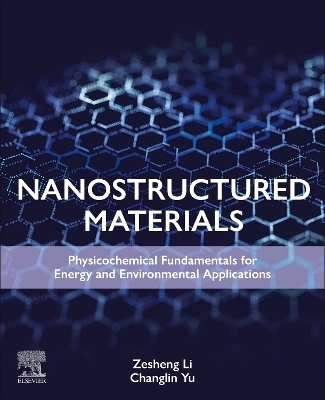
Nanostructured Materials
Elsevier - Health Sciences Division (Verlag)
978-0-443-19256-2 (ISBN)
Efficient use of energy, eco-friendly environmental systems, and technologies play an important role in global sustainable development. Multifunctional nanocomposites have excellent properties and can meet the practical needs of energy development and environmental treatment. They have been gradually applied in chemical materials, energy preparation, pollution control and other fields and have achieved impressive development.
Zesheng Li has been engaged in the scientific research of electrochemical energy materials and environmental catalytic materials (fuel cell electrocatalytic materials, electrochemical energy storage electrode materials, solar photocatalytic materials). he has accumulated some research experience in the design, synthesis, and functional regulation of nano materials (including SACs) and achieved interesting research results. In the past eight years, as the first author, corresponding author and second author, he has been published in important international academic journal of materials, chemistry, and chemical engineering: Adv. Mater., Chem. Commun., J. Mater. Chem. A, ACS Appl. Mater. Inter., J. Power Sources, Int. J. Hydrogen Energy, Electrochim. Acta, Chem. Eng. J. and other journals published 42 SCI research papers (26 first authors). There are 23 papers in JCR zone 1, 8 papers in JCR zone 2 and 11 papers in JCR zone 3 of the Chinese Academy of Sciences; 1 if ≥ 15, 10 if ≥ 6, 25 If ≥ 3; SCI papers have been cited for more than 2000 times, and the h index is currently 19 (19 papers have been cited for more than 19 times), the highest single article cited for more than 380 times (Adv. mater., 2013, 25, 2474-2480), the second highest for more than 120 times (J. mater. Chem., 2010, 20, 3883-3889), and the third highest for more than 80 times (Chem. Eng. J., 2014, 241, 344-351). Two papers (Chem. Eng. J., 2014, 241, 344-351; Chem. Eng. J., 2017, 313, 1242-1250) have been cited by ESI (1%). Changlin Yu is mainly engaged in the application research of environmental catalysis, catalytic reaction engineering, environmental purification materials and catalytic technology in the treatment of organic wastewater and waste gas. He is the editorial board member of four journals including the international first district Journal Chinese Journal of Catalysis (impact factor 6.3), applied catalysis B, Chemical Engineering Journal, Reviewers of more than 100 international important academic journals such as journal of hazardous materials. He has published more than 200 SCI high-level journals, including advanced materials (if28.80), applied catalysis B (4, if16.2), Journal of Materials Chemistry A (4, if11.49), Chemical Engineering Journal (4, if10.35), Journal of Catalysis (4, if7.72), etc.
Part One: Design fundamentals of nanomaterials1. Introduction2. Structure types and characteristics of nanomaterials3. Structure-performance relationship of nanomaterials4. Physicochemical basics and paradigms of nanomaterials5. Synthesis methods and paradigms of nanomaterials6. Characterization techniques and paradigms of nanomaterials
Part Two: Application types of nanomaterials in energy and environment fields7. Supercapacitor: basic principles, electrode materials and applications8. Metal-ion battery: basic principles, electrode materials and applications9. Metal-air battery: basic principles, electrode materials and applications10. Metal-sulfur battery: basic principles, electrode materials and applications11. Fuel cells: basic principle, electrode material and applications12. Solar cells: basic principles, electrode materials and applications13. Electrocatalysis for energy conversion and environmental protection: fundamentals14. Photocatalysis energy conversion and environmental protection: fundamentals15. Sustainable production of energy gases: the function of nanomaterials16. Selective separation and storage of energy gases: the function of nanomaterials17. Adsorption in the treatment of three wastes: fundamentals18. Advanced oxidation in the treatment of three wastes: fundamentals
Part Three: Application cases of nanomaterials in energy and environment fields19. 3-D graphene nanosheets: recent progress in energy and environmental fields20. Hollow carbon nanocages: recent progress in energy and environment fields21. Nano porous activated carbon: recent progress in energy and environment fields22. Nano manganese oxides: recent progress in energy and environment fields23. Nano stannic oxides: recent progress in energy and environment fields24. Nano nickel sulfides: recent progress in energy and environment fields25. Nano tungsten carbides: recent progress in energy and environment fields26. Nano polyaniline: recent progress in energy and environment fields27. Nano graphitic carbon nitride: recent progress in energy and environmental fields28. Nano bismuth oxometallates: recent progress in energy and environmental fields29. Nano MAXene: recent progress in energy and environmental fields30. Nano layered double hydroxide: recent progress in energy and environmental fields31. Nano Perovskite: recent progress in energy and environmental fields32. Atomically-dispersed catalysts: recent progress in energy and environmental fields
Part Four: Opportunities, challenges, and future outlooks33. Opportunities34. Challenges35. Future Outlooks
| Erscheinungsdatum | 09.09.2023 |
|---|---|
| Verlagsort | Philadelphia |
| Sprache | englisch |
| Maße | 191 x 235 mm |
| Gewicht | 1200 g |
| Themenwelt | Medizin / Pharmazie ► Medizinische Fachgebiete ► Pharmakologie / Pharmakotherapie |
| Medizin / Pharmazie ► Pharmazie | |
| Technik | |
| ISBN-10 | 0-443-19256-1 / 0443192561 |
| ISBN-13 | 978-0-443-19256-2 / 9780443192562 |
| Zustand | Neuware |
| Informationen gemäß Produktsicherheitsverordnung (GPSR) | |
| Haben Sie eine Frage zum Produkt? |
aus dem Bereich


